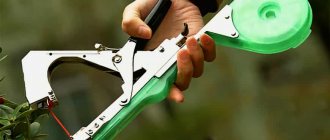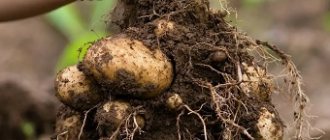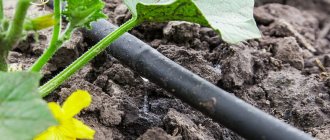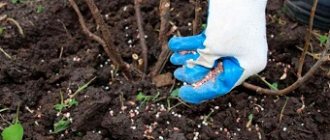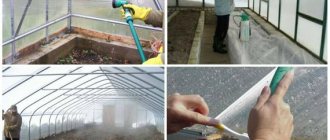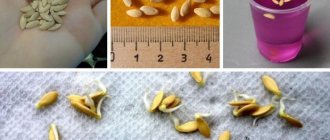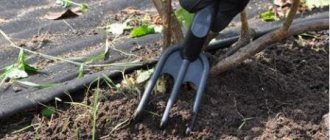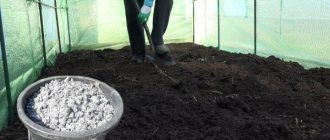The article describes in detail how to care for raspberries in order to have a good harvest. In spring, summer, autumn and winter: features of watering, fertilizing, pruning shrubs and its remontant varieties.
How to grow raspberries so as to get a large harvest of this very tasty and aromatic berry? Many gardeners ask this question. This plant loves warmth and light, but not everyone knows how to care for it. Although, first of all, in order to get a large and tasty berry, you need to choose the right variety. But which one exactly depends on your area. In addition, you need to properly water the raspberries, prune them, fertilize and fertilize them. This is all very important for proper cultivation and obtaining a rich harvest. Raspberries can also be regular or remontant, and their spring, summer, and autumn care is noticeably different.
Caring for raspberries: preparation for planting, predecessors
Caring for raspberries: preparation for planting, predecessors
The best raspberry predecessors
In order to grow raspberries, the first thing you need to do is choose the right site. At the site of the future raspberry tree there should not be the slightest draft, wind or shadow. The site should have direct sunlight all day, and the groundwater should be as deep as possible. The best place would be along the house or fence. If the place where raspberries grow is chosen incorrectly, this is immediately visible from the outside. Signs of an incorrectly chosen location: small berries - the raspberry does not have enough moisture, which means it is growing in too high a place. Root rotting - there is too much moisture, which means it is growing in a place where groundwater is too close. Dying of stems - raspberries grow in the wind, which means they have too much draft and too much shade. Freezing of buds - bushes grow in too low a place
You also need to choose the right predecessors for raspberries. The best for it will be beans, peas and lentils, but if apple trees, potatoes or strawberries previously grew in this place, then the harvest will be poor. You also need to prepare the ground before planting, because it loves light and loose soil. Raspberry is a subshrub, and its roots are located quite close to the surface of the earth. That is why it only needs 30 cm of fertile soil layer, but the soil must be quite acidic, otherwise it will produce a poor harvest. When you have decided on a place for a raspberry garden, you need to prepare the soil. They begin to do this 2 weeks before planting. When digging in autumn, you need to add rotted manure and 70 grams of superphosphate or 50 grams of potassium sulfate to the site; this is the amount of fertilizer that needs to be applied per 1 square meter of land.
Lots of light
Raspberries do not tolerate dark areas. It can tolerate a little shade in the morning and evening hours. But throughout the day the plant requires a sufficient amount of sunlight. Then it will be able to develop well and produce tasty fruits.
Accordingly, if raspberries are planted in an area where there is not enough natural light, it is worth replanting them in the fall or spring in a sunny place. The results will be immediate and you will soon be able to see a significant difference in your yield.
Caring for raspberries: planting methods
Caring for raspberries: planting methods
The entire future harvest depends on how correctly the raspberries were planted. When planting, experienced gardeners recommend choosing the trench method. The correct choice of method for planting raspberries also gives results. The correct technique for planting raspberries:
1. It is necessary to prepare trenches 2.5 meters long and up to half a meter deep. 2. humus and compost should be poured into the bottom of the trenches. 3. You need to pour a layer of soil of at least 10 cm on top of the fertilizer. 4. You need to carefully place the raspberry seedlings in the trench and straighten the roots, which should be at a distance of half a meter from each other. 5. During installation, the seedling must be gently shaken so that no voids form between the roots and the ground. 6. The replacement kidney should be no deeper than three cm underground. 7. The bushes must be carefully covered with earth and compacted very firmly. 8. The seedlings need to be watered very generously, but the water must be warm, not lower than 20 degrees. The bush grows in one place for 5 years, and throughout its entire length it will be nourished by the fertilizer that was added to the trench during planting. After all, it is within five years that organic fertilizers will decompose. Since raspberry bushes grow very quickly and strongly, the trenches should be located at a distance of 1.5 meters from each other. If the row spacing is small, then there will be little space for the raspberries, and it will be very inconvenient to pick raspberries.
Mulching
To retain moisture in the soil, it needs to be mulched. Throughout the summer you need to constantly add mulch. It could be:
- Straw,
- Peat,
- Sawdust.
Grass, that is, ordinary garden weeds, is also applicable. But first you need to remove the seeds, otherwise they may germinate in the raspberries.
Proper watering and loosening to get a good raspberry harvest
Proper watering and loosening to get a good raspberry harvest
If you want to get a large harvest of raspberries, then do not forget about watering. Raspberries should always be watered, at all stages of their development. To prevent water from simply spreading on the ground around it, it is best to install a frame. It can be made of wooden boards or slate, and dug to a shallow depth. If for some reason you cannot make a frame, then you can simply make an earthen embankment around the perimeter and the water will not go anywhere. It is best to water raspberries twice a week, but generously enough so that the soil gets wet to a depth of at least 30 cm. Proper and regular moistening of the soil promotes the growth and active development of shoots, which must gain strength before active fruiting begins. Therefore, from the end of May to July, you need to increase the amount of water during watering; each bush at this time should use approximately half 30 liters of water at a time. It is advisable to water raspberries late in the evening so that the water has time to be absorbed overnight. But if you water in the morning, then during the day a large amount of moisture will evaporate and will not have time to reach the roots of the plant. A very good method is drip, using special installations. This method is quite convenient and the soil in the raspberry garden will always be moist, but in terms of the amount of water it is quite expensive, since the consumption of water for each watering will be much greater than when watering by hand.
When raspberries are already growing on the plot, there is no need to dig up the ground near the bushes; the roots can be damaged because they are too close to the surface of the earth. But the row spacing must be loosened, and this is done so that oxygen can more easily enter the bud, and the weeds are removed immediately. Loosening the soil is a very good way to increase productivity. The first time to loosen the soil in a raspberry field is in early spring, immediately after the snow has completely melted and stable warm weather has established. Loosening is also carried out after each watering. To avoid watering raspberries too often, simply mulch the soil. this can be done with dry sawdust, grass, straw or hay. You need to loosen the soil throughout the entire season, and the last time this should be done before mid-August. If you carry out loosening later, the young shoots will not have time to develop as they should, and in winter they will simply freeze. During the last loosening, you can make a slope towards the bushes so that all the autumn moisture gets to the roots of the plant, and not just into the empty soil.
In order for the humidity to be optimal for the life of raspberries, it is best to mulch the root zone of the plant. You can even sprinkle a little manure under each bush, then when it dries, the crust it forms will prevent moisture from evaporating from the ground. It is also suitable as an excellent organic fertilizer. And while it decomposes over several years, all this time it will feed the raspberries with useful substances. But you must definitely monitor the volume of manure mulch on raspberries, because it should not be higher than 5 cm, otherwise it will be very difficult for young shoots to break through it, and some will not be able to break through it at all, because the manure itself is very heavy. If you do not have manure available and cannot purchase it, then you can mulch raspberries with: peat, fallen leaves, dry grass, dry sawdust, a mixture of sawdust with the addition of wood ash, old newspapers, which should be lightly sprinkled with humus. If for some reason you do not want to mulch, then you can simply cover the rows with a covering material that does not allow light to pass through. Then there will be an optimal amount of moisture underneath and sufficient temperature to prevent weeds from growing.
Removing excess growth
Do not think that the larger the bush, the higher the yield you will get from it. Thickened raspberries grow weak and are more often susceptible to diseases and pest attacks.
The plant spends a lot of energy and nutrients on the growth of shoots, and this can reduce the volume of the harvest. To avoid this, leave no more than 7-8 fruiting shoots on each bush. Remove all weak growth during the season. Especially if you do not plan to grow remontant raspberries.
The growth that appears at a distance of more than 25 cm is removed with a sharp shovel. Since the raspberry root is shallow, the shovel is buried 15-20 cm.
Raspberry care: feeding raspberries for a good harvest
Raspberry care: feeding raspberries for a good harvest
It is necessary to fertilize raspberries, then the plants will receive more nutrition and, accordingly, develop more. And on well-developed branches with a thick stem and plenty of foliage, the harvest will be greater. As a top dressing for raspberries, chicken droppings or slurry diluted with water in a ratio of 1:10 are excellent. And also rotted manure from last year. If for some reason, when preparing the trenches in the fall, you were unable to fertilize the soil with organic matter and did not add a fertile layer of soil, then the first fertilizing can be done in the spring by adding urea in the form of granules to the trenches. No more than 100 grams of fertilizer should be applied per 1 square meter. When the first ovaries appear on raspberries, ideally they should be fed with minerals that contain phosphorus, calcium, sulfur, potassium and magnesium. The most optimal drug, which contains all these necessary substances, is superphosphate. This drug strengthens the raspberry's immunity, the shoots become stronger, and the quantity of berries increases. Although for raspberries, organic fertilizers will always be a priority. Manure, slurry, chicken manure, compost and peat mixed with manure are perfect for her. But under no circumstances should you feed raspberries with nitrogen in the fall, as it greatly reduces the frost resistance of plants.
When the raspberries begin to bloom, you can make the ideal fertilizer for raspberries yourself. To do this, you need to take: 200 grams of superphosphate, 200 grams of pure wood ash without impurities, 60 grams of urea and dilute all this in 10 liters of water. Each raspberry bush should be watered with this solution. If the raspberries have already begun to bear fruit, then after the very first pruning they need to be fed with nitroammophoska, applied in the amount of 40 grams of the drug per 1 square meter of land. This fertilizer is applied during the 4th year of the plant’s life. Also in the fall, 3 liters of humus mixed with 100 grams of saltpeter should be added to each bush.
How to increase fruiting
Several factors influence the size of the berries and the volume of the harvest:
- water;
- feeding;
- pruning
Raspberries love water . Moisture has a major effect on the size and taste of berries. Water sufficiently every 3-4 days. To better saturate the soil, divide the watering into 2 parts and water it with an interval of 1 hour.
Always try to use organic fertilizers . They are released gradually, providing the plant with nutrition as needed. Raspberries spend a lot of energy on fruiting, so without fertilizing the yield will be significantly lower.
If you want large, juicy and sweet berries, you must provide the plant with water, nutrition and choose the right pruning method for your varieties.
If you cut off branches of the second year on remontant varieties, this also reduces the yield. Although some gardeners note that this increases their yield on the shoots of the first year. It is also necessary to shorten tall varieties. A shoot that stretches up to 2–2.5 m will not increase fruiting, but will reduce it, since a lot of energy will be spent on the development of the shoot itself.
Raspberries: care, pruning, garter
Raspberries: care, pruning, garter
Raspberry care: pruning
The number of flowering clusters, and subsequently the number of berries, is determined when pruning the bushes. When pruning annual raspberries, it is best to use the double pruning method. This method belongs to the breeder Alexander Sobolev.
The first time pruning raspberries is carried out in the second year of the plant’s life. And they do this from the end of May to the beginning of June, because it is at this time that the young shoots begin to grow upward. They need to be cut at a height of 1 meter above the ground, this will be more convenient for everyone, for raspberries in that the branches will not bend too much under the weight of the berries, and sometimes even break. And for the gardener it is much more convenient to harvest, and there is no need to reach anywhere. Repeated pruning is carried out next spring, when the bush already has many young shoots, and they need to be trimmed literally by 10 cm.
When pruning each bush annually, it is advisable to leave no more than 5 young shoots, and the rest must be mercilessly trimmed with pruning shears. In the case of such pruning, the raspberries will lay much more flowering buds, and accordingly the amount of the future harvest will increase. You can also increase the fruiting of raspberry bushes if you grow young bushes and those already bearing fruit separately. For this method, young and strong shoots are dug up and replanted separately, while small and weak shoots are simply cut out. If you plant late-ripening raspberry varieties, then only those shoots that have grown to three years of age will bear fruit. Such shoots need to be cut to a height of 1.5 meters from the ground. Then such bushes will produce only large berries.
As raspberry bushes grow, they will need additional support over time. There are various methods of gartering for this, and each gardener chooses the method that is more convenient for him. For example, many people make trellises and stretch thick wire between them, and every year the number of wires increases, both at the top and at the bottom. But there should be a distance of at least 30 cm from the ground below. And this is the distance that is left so that during autumn preparation, young shoots can be tied to this wire for the winter in order to save them from freezing. And the stems of old shoots are tied to the upper trellis, where they are well ventilated, and this reduces all the risks of raspberry infection with viral diseases. There are several other advantages to such a garter: there is much less load on the plant branches, raspberries are much easier to care for, young and already fruiting shoots can be divided without replanting. Also, if there is no thickening in the raspberries, then you can install pegs next to each shoot and tie the shoots to them. The fan method of gartering plants is also often used. To do this, two stable pegs are driven into the ground opposite each other and the shoots are tied to the stakes in turn. Thus, a kind of fan is obtained.
The third secret is growing on a trellis
Raspberries should grow in even rows, with a distance of at least 50 cm between bushes in a row, all shoots raised and secured to a trellis. This way, the raspberries are evenly illuminated by the sun along the entire length of the stem, which means they lay more hearth branches from bottom to top and are less affected by diseases.
Often after rain or during harvest, the stems fall, the berries end up on the ground, become damaged, and rot.
When grown on a trellis, the berries always remain clean and appetizing.
Raspberry care: protection from diseases and pests
How to protect raspberries from various diseases and pests interests many, even experienced gardeners. Even if you do everything correctly in caring for raspberries, you can still lose your entire plantation due to some disease or pest. Their appearance may not immediately destroy the entire crop, but certainly half. If insects attack a raspberry during flowering, they will immediately damage the flowers and buds of the plant.
The main pests and how to deal with them: Raspberry beetle - this pest lays larvae in flowers. It is very difficult to get rid of them unless you collect them manually. You can also lay a film on the ground around the bush and shake off the larvae from each branch. Spider mites and stem flies - these pests can only be poisoned with insecticides such as Decis or Iskra. Bud moth - this insect especially often affects young shoots. To get rid of it, you need to treat the raspberries with a 10% solution of Bordeaux mixture or karbofos. Stem gall midge - infestation with this pest is immediately visible externally; orange swellings appear on the lower shoots. If this pest does appear, then you need to cut it below the lowest swelling, and be sure to treat the raspberries with Fufanon or Actellik. Strawberry-raspberry weevil - the larvae of this insect eat the flower buds from the inside. To get rid of this pest, you need to treat raspberries with karbofos. The chemical is called “Confidor.” Aphids—it’s very easy to understand that your plant has been attacked by this particular pest. The leaves simply begin to curl, the young shoots grow crooked, and when the raspberries bloom, the flowers simply dry out and fall off. This pest also easily transmits viral diseases. But you can get rid of it either before the raspberries begin to bloom, or wait until the harvest is ripe and you collect it. Raspberries are treated with preparations such as Iskra-M or Actellik. Nutcracker - the larva of this insect feeds on the tissues of raspberry leaves and stems. To get rid of it, you need to treat raspberries with chemicals such as “Alatar” or “Inta-Vir”. Raspberry glassworms are caterpillars that feed on the roots and stems of the plant, penetrating inside. In order to get rid of them, you need to cut out all the affected branches and especially the lower shoots, and they also need to be burned, and one of the main conditions for their destruction is that you need to burn them outside your area.
You should always remember and not make this global mistake: you cannot treat plants with any chemicals when the plant is blooming, or even just being harvested. And before you harvest, you shouldn’t treat raspberries with chemicals at all. This is fraught with poisoning. It is better to have time to carry out the treatment before flowering, or after harvesting.
To prevent insects from hatching from larvae during flowering, you need to use the folk method. Every evening you need to treat the raspberry bushes with a cold infusion of tansy. For this infusion you need: 500 grams of fresh tansy and 200 grams of dried tansy, pour 2.5 liters of water over them and boil for 30 minutes. Then you need to strain this solution and fill it with another 2.5 liters. It must be cooled well before use. And so that insect larvae cannot survive the winter in the ground, in the fall all row spacing must be dug up to the depth of a bayonet shovel.
Raspberries also often suffer from various diseases. They can also be immediately seen externally: didimela - also called blue-violet spotting. When this disease appears, spots appear under the leaf petiole. It can spread very quickly, and buds stop developing on infected bushes.
Powdery mildew - when this disease appears, the leaves and stems of the plant become covered with a white coating, and the amount of harvest becomes much less than expected. The berries are small, blue-gray in color, and have a specific smell. Anthracnose - purple spots appear on the plant, somewhat similar to cankers. These spots can be located on absolutely any part of the plant. With this disease, the berries do not ripen at all. Septoria - with this disease, the leaves are affected by white spots and die. Curly - the leaf becomes like glass and begins to curl towards the center. Bacterial root cancer - balls appear at the very base of the shoots, somewhat reminiscent of a tumor. The plant gradually weakens and eventually dies off altogether. Diseases can only be overcome with the help of chemicals. The best drugs in the fight against diseases are: “Hom”, “Oxy-Hom”, “Abiga-Pik”, Bordeaux mixture 1%, copper chloride.
Raspberry care: disease prevention
It is best to carry out prevention than to continue treatment and waste your time and energy on it. For prevention you need:
1. Thin out the bushes, preventing them from thickening. 2. Every autumn you need to trim and burn insect-infested branches. 3. Every autumn, dig between the rows and regularly loosen the raspberry tree itself. 4. Raspberries should never have weeds at all. 5. It is best to cover it with covering material until the raspberries begin to form buds. 6. replant raspberries to a new site every 5 years. 7. An excellent preventive measure when planting is to treat the roots in a 1% solution of copper sulfate. More precisely, the roots need to be completely washed in copper sulfate and then washed in the same way in plain water. 8. You also need to choose the right raspberry varieties and choose good and healthy seedlings for planting. 9. Also, to prevent diseases in the spring, you can treat raspberry plantings with rubigan solutions. Dilute 2 ml of the drug into 5 liters of water. Or benomyl 1 gram is also diluted in 5 liters of water.
Caring for raspberries: features and secrets
If you properly care for raspberries throughout the year, you will get a correspondingly large harvest. After all, each season caring for raspberries is a little different from the previous one. And accordingly, the care needed is a little different.
In spring you need to prune properly. And this is done in order to remove all dried branches that did not survive the winter or broken ones. But do not forget that you do not need to open the raspberries, insulated for the winter, as soon as the first warm days have arrived. Moreover, when the shoots were pressed to the ground in the fall for better insulation. After all, firstly, spring frosts may still return, and secondly, the shoots simply do not have time to warm up yet, and after winter they are still very fragile and may simply break. You can open raspberry shoots only when the daytime temperature is consistently above +10 degrees. If you tied the stems, then after opening them you just need to untie them, but under no circumstances should you unbend them. Over time they will straighten out on their own. But after they straighten themselves, they will need to be tied up. And pruning is carried out only in May, not earlier.
It is in the summer that raspberries begin to bear fruit. When the berries are ripe, they need to be picked at this time every two days. This is simply necessary so that the branches do not break under the weight of the berries. Throughout the summer period, in addition to the fact that in the summer you need to water the raspberries, feed them and loosen them, you also need to prune the young shoots. After all, the bushes will give up their strength to the shoots, and there will be no strength left for the berries. Before flowering begins, you need to thin out the raspberries so that there are no overgrowths, and you can also treat the raspberries with copper sulfate. Do not spare the young shoots, new ones will always have time to grow, but you need to take into account the fact that they cast a shadow on the fruit-bearing branches and take all the moisture and nutrients from the ground. But if you thin out raspberries, the plants will be stronger and the harvest will be larger. Experienced gardeners also recommend pruning two-year-old shoots in the summer. Then all the new shoots will have time to strengthen well before the next season.
In autumn, pruning should be done before sheltering for the winter. For planned pruning of raspberries, as well as for thinning them, early autumn is the most ideal option. It is at this time that the regrown shoots are already formed and watering can be almost halved. Before closing the raspberries for the winter, they need to be watered very generously one last time; at least 5 buckets of water should be poured onto each square meter. At the very beginning of October, absolutely all leaves should be removed from raspberries and the shoots should be bent to the ground. If you do this later, the branches will simply dry out and when you bend, you will most likely break them.
You also need to change the mulch, dig up the rows and loosen the soil. And this is done in order to destroy all insects that can survive the winter. You can also start feeding raspberries with potassium from the very beginning of September. On zoom, in addition to bending the branches to the ground, you also need to cover them with something like film. Also, before winter, you need to carry out another pruning and cut out all the shoots that have already bear fruit. Raspberries are a very frost-resistant plant that can easily tolerate temperatures down to -36 degrees without loss. But despite this, insulation is still needed for the winter. The insulation will also trap snow.
Caring for raspberries of remontant varieties
There are also remontant varieties, but they require slightly different care. But the yield of these varieties is much higher than that of ordinary raspberries. And it bears fruit longer. In principle, caring for regular raspberries and remontant raspberries is similar, only the latter has its own characteristics. It is best to plant remontant raspberries in the fall, in the very first days of October. In order to increase the amount of harvest, you need to completely cut out the fruit-bearing bushes. And it is best to do this in the fall, or at least in the early spring. But if you cut it in the spring, then you don’t have to wait for the harvest this year; it will appear only next year. So the choice of when to cut remontant raspberries is up to you. For remontant raspberries, thinning the bushes is especially important, because the denser the bushes are, the fewer berries they will bear, and even those will be small. These raspberries need increased feeding, because due to the fact that they produce a larger harvest, they therefore spend more energy.
Remontant raspberries, just like regular ones, need to be planted in a place where there is no draft, preferably along a house or fence. What is the difference between remontant raspberries and regular ones: Remontant raspberries can be harvested at least twice per season. There is no need to bend the stems to the ground for the winter and cover it. Pruning remontant raspberries is a little easier than regular ones.

